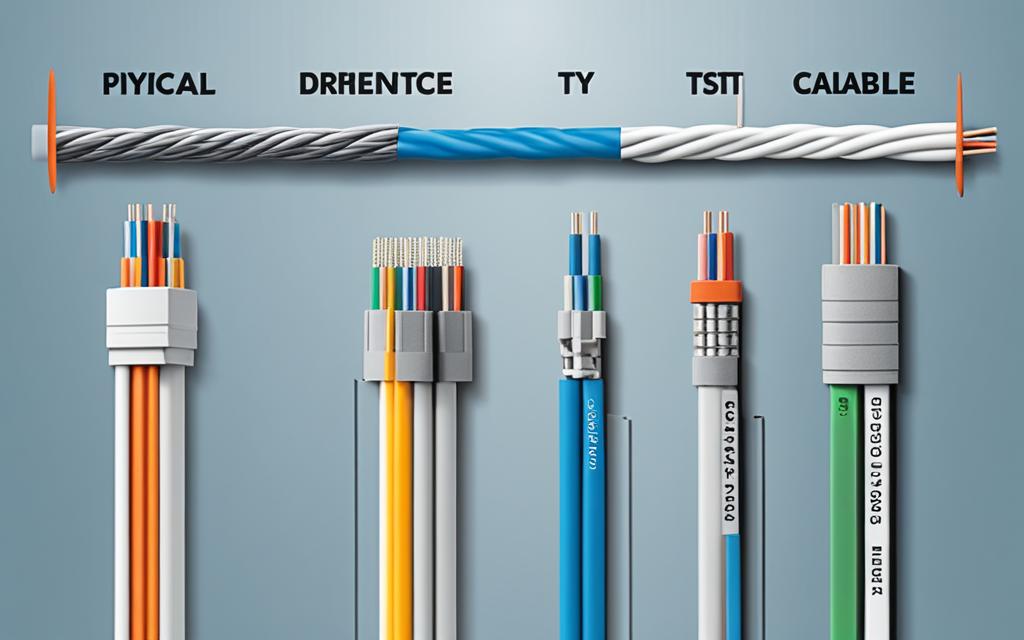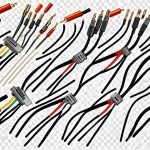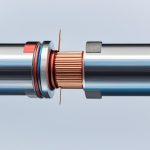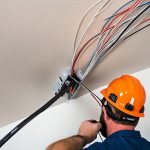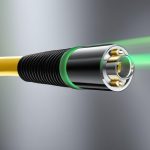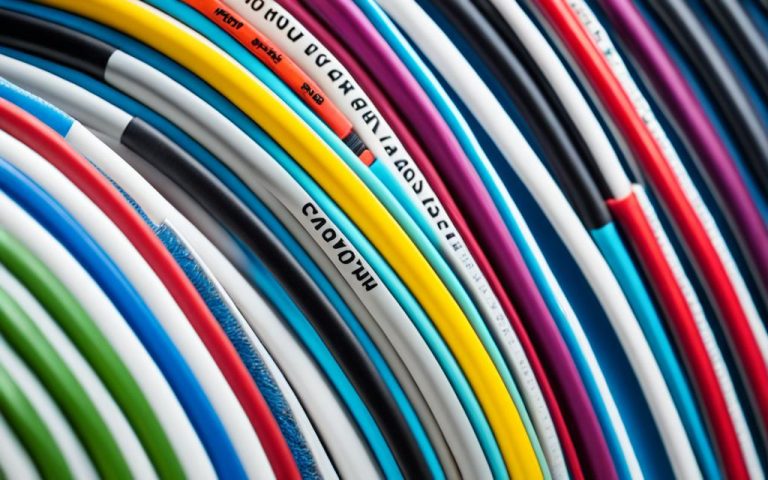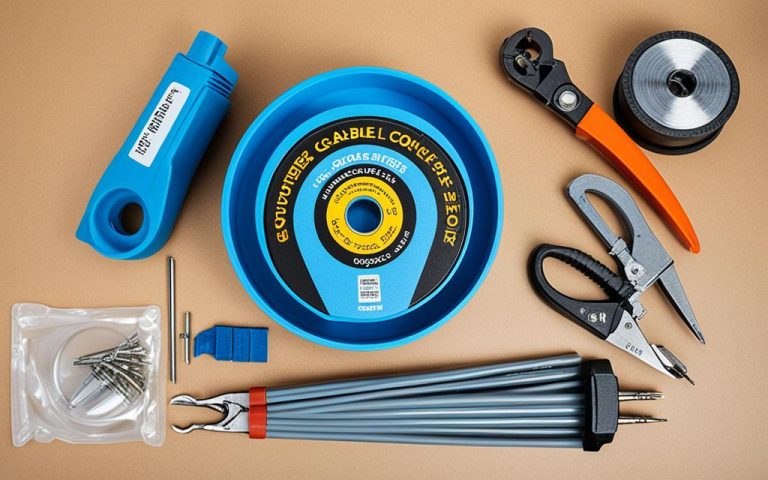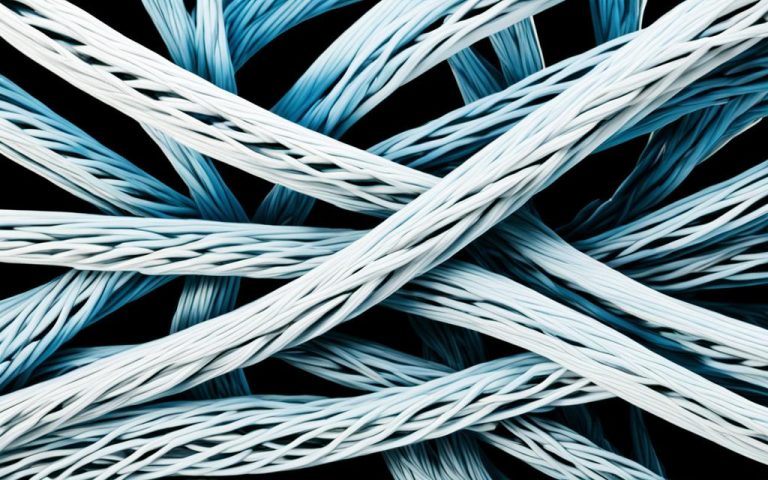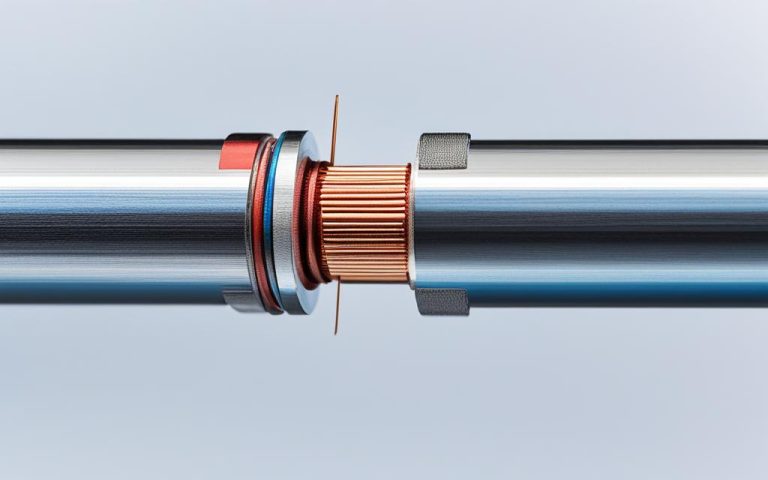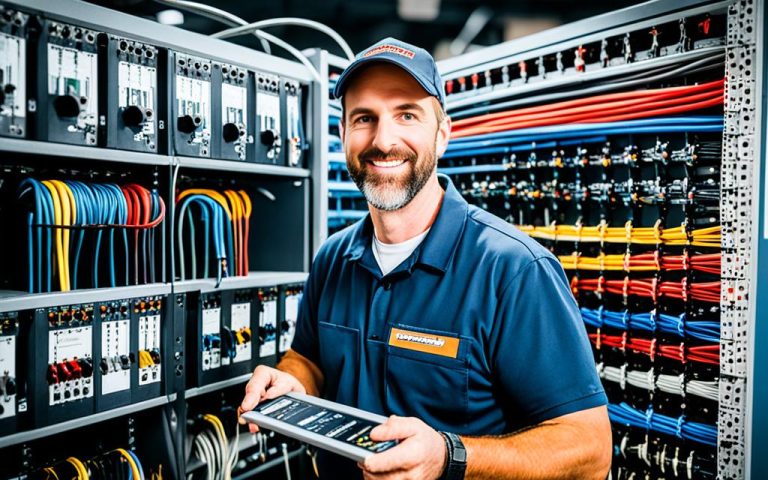Welcome to our article on the comparative analysis of coaxial cable and twisted pair cable networks. In today’s digital age, reliable and efficient network connectivity is essential for seamless communication and data transmission. Coaxial cable and twisted pair cable are two common types of transmission media used for networking purposes.
Coaxial cable consists of a solid conductor, insulation, and a grounding conductor, while twisted pair cable comprises two insulated copper wires twisted together. Coaxial cable is often used for internet connections, television signal distribution, and radio transmissions, while twisted pair cable is primarily used in telephone networks and cable shielding.
Throughout this article, we will explore the advantages and disadvantages of both coaxial cable and twisted pair cable networks, as well as highlight their similarities and differences. By understanding the unique features and capabilities of each type, you will be better equipped to make informed decisions when it comes to choosing the right network cable for your specific needs.
Continue reading to uncover the advantages, disadvantages, and other key insights into coaxial and twisted pair cable networks.
Advantages and Disadvantages of Coaxial Cable
Coaxial cable has several advantages over twisted pair cable, making it a preferred choice for certain networking applications. Here are the key benefits of using coaxial cable:
Better Shielding and Signal Quality
Coaxial cable offers superior shielding, which reduces signal interference and enhances overall signal quality. This shielding design prevents external electromagnetic interference from affecting the transmitted signals, resulting in a more stable and reliable connection.
Longer Distance Transmission
One of the primary advantages of coaxial cable is its ability to transmit signals over longer distances without significant degradation. This makes it ideal for applications that require data transmission over extended distances, such as cable television distribution and long-range network connections.
Higher Bandwidth for Fast Data Transmission
Coaxial cable has a higher bandwidth capacity compared to twisted pair cable. This allows for faster data transmission speeds, enabling quicker downloads, seamless streaming, and efficient communication in high-demand network environments.
However, it’s important to consider the drawbacks of coaxial cable before making a decision. These disadvantages include:
Higher Cost
Coaxial cable tends to be more expensive than twisted pair cable, both in terms of cable itself and the associated connectors and installation equipment. This cost factor may impact budgets for large-scale network deployments or projects with budget constraints.
Difficult Installation, Especially in Tight Spaces
Installing coaxial cable can be challenging, particularly in tight spaces or existing structures where running the cable becomes complicated. The cable’s thickness and rigidity may necessitate drilling and modifications, making the installation process time-consuming and potentially disruptive.
Limited Availability in Some Areas
While coaxial cable is commonly used and widely available, it may not be as accessible as twisted pair cable in certain areas. This could be due to regional network infrastructure limitations or industry-specific preferences for different cable types.
Despite these disadvantages, coaxial cable remains a reliable and efficient choice for various networking applications.
Advantages and Disadvantages of Twisted Pair Cable
Twisted pair cable offers several advantages and disadvantages in networking applications. Here, we will outline the key benefits and drawbacks of using twisted pair cable as a transmission medium.
Advantages of Twisted Pair Cable
- Economical: Twisted pair cable is generally more affordable than coaxial cable, making it a cost-effective option for network installations.
- Easy Installation: The flexibility and smaller size of twisted pair cable make it easier to install, especially in tight spaces where coaxial cable may pose challenges.
- Widely Available: Twisted pair cable is commonly used and readily available, making it a convenient choice for networking projects.
Disadvantages of Twisted Pair Cable
- Signal Interference: Twisted pair cable is more susceptible to signal interference from external sources such as electromagnetic fields, which can degrade the quality of the transmitted data.
- Transmission Distance Limitations: Twisted pair cable has a limited transmission distance compared to coaxial cable, requiring additional equipment like repeaters or switches for longer distances.
- Lower Bandwidth: Twisted pair cable has a lower bandwidth compared to coaxial cable, resulting in slower data transmission speeds.
Despite these disadvantages, twisted pair cable remains a popular choice in various networking applications due to its affordability, ease of installation, and wide availability.
To visualize the advantages and disadvantages of twisted pair cable, refer to the table below:
| Advantages | Disadvantages |
|---|---|
| Economical | Signal Interference |
| Easy Installation | Transmission Distance Limitations |
| Widely Available | Lower Bandwidth |
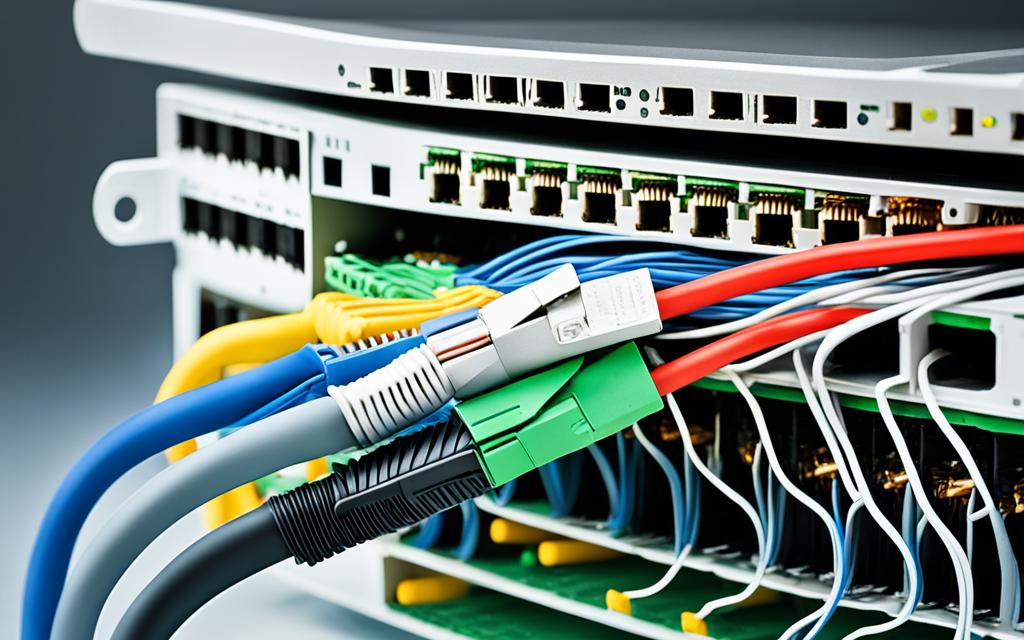
Similarities between Coaxial Cable and Twisted Pair Cable
Despite their differences, coaxial cable and twisted pair cable share some similarities. Both types of cables can transmit data in networking applications, have multiple layers of insulation and shielding, and are used for various purposes, such as in LANs, WANs, and internet connections.
“Coaxial cable and twisted pair cable both play a crucial role in modern networking systems, providing reliable transmission of data and signals.”
In addition to their common usage, both coaxial cable and twisted pair cable can support different transmission protocols, such as Ethernet, Token Ring, and FDDI. This flexibility allows for compatibility with a wide range of network devices and configurations.
Furthermore, both coaxial cable and twisted pair cable have different variations based on their characteristics and usage. Coaxial cable, for instance, has thinnet (RG-58), thicknet (RG-8), and RG-6 variations, among others. Similarly, twisted pair cable comes in different forms, such as Unshielded Twisted Pair (UTP) and Shielded Twisted Pair (STP).
“Coaxial cable and twisted pair cable offer choices in terms of variations, enabling network designers to select the most suitable type for their specific requirements.”
Overall, these shared attributes highlight the versatility and importance of both coaxial cable and twisted pair cable in modern networking systems.
Summary of Similarities:
- Transmission of data in networking applications
- Multiple layers of insulation and shielding
- Usage in LANs, WANs, and internet connections
- Support for various transmission protocols
- Different variations based on characteristics and usage
“Both coaxial cable and twisted pair cable play a vital role in modern networking systems.”
Differences between Coaxial Cable and Twisted Pair Cable
When comparing coaxial cable and twisted pair cable, it’s important to understand their distinct differences. These dissimilarities impact various aspects of their functionality and performance. Let’s explore the dissimilarities in transmission, speed, noise protection, bandwidth, cost, node capacity, variations, electromagnetic interference, and attenuation.
Transmission:
Coaxial cable transmits signals through the inner conductor, while twisted pair cable transmits signals through the metallic conducting wires.
Speed:
Coaxial cable has a maximum speed of up to 10 Mbps, whereas twisted pair cable can achieve speeds of up to 10 Gbps.
Noise Protection:
Coaxial cable provides better noise protection compared to twisted pair cable, ensuring a higher level of signal integrity and purity.
Bandwidth:
Coaxial cable offers a moderate range of bandwidth, enabling higher data transfer rates. On the other hand, twisted pair cable has a lower bandwidth, resulting in comparatively slower data transmission speeds.
Cost:
The cost of coaxial cable is generally higher than twisted pair cable, making it a less economically viable option for some networking applications.
Node Capacity:
The node capacity varies between coaxial cable and twisted pair cable, with each type having its own limitations in terms of the number of connected devices they can support.
Variations:
Coaxial cable comes in different types, including RG-6, RG-11, and RG-59, each designed for specific applications. Twisted pair cable has variations like Unshielded Twisted Pair (UTP) and Shielded Twisted Pair (STP), providing diverse options to suit various networking requirements.
Electromagnetic Interference (EMI):
Coaxial cable is less affected by electromagnetic interference, maintaining signal stability and quality. In contrast, twisted pair cable is more susceptible to EMI, which can potentially impact its performance.
Attenuation:
Coaxial cable exhibits lower attenuation compared to twisted pair cable. This means that coaxial cable can transmit signals over longer distances with less signal loss.
| Comparison Factor | Coaxial Cable | Twisted Pair Cable |
|---|---|---|
| Transmission | Inner conductor | Metallic conducting wires |
| Speed | Up to 10 Mbps | Up to 10 Gbps |
| Noise Protection | Better | Lower |
| Bandwidth | Moderate | Lower |
| Cost | Higher | Lower |
| Node Capacity | Varies | Varies |
| Variations | Types: RG-6, RG-11, RG-59 | UTP, STP |
| EMI Impact | Less impacted | More impacted |
| Attenuation | Lower | Higher |
It’s evident that coaxial cable and twisted pair cable differ significantly in various aspects, such as transmission method, speed, noise protection, bandwidth, cost, node capacity, variations, susceptibility to electromagnetic interference, and attenuation. Understanding these differences is crucial for selecting the appropriate cable option based on specific networking requirements.
Coaxial Cable and Twisted Pair Cable vs Fiber Optic Cable
In addition to coaxial cable and twisted pair cable, fiber optic cable is another type of network cable commonly used for high-speed and long-distance transmission. Fiber optic cables can carry more data than coaxial or twisted pair cables, and they are also durable and relatively easy to install.
The choice between coaxial cable, twisted pair cable, and fiber optic cable depends on the specific requirements of the networking application. Coaxial cable is preferred for long-distance transmission and high bandwidth, twisted pair cable is suitable for easy installation and cost-effectiveness, and fiber optic cable is ideal for high-speed and long-distance applications.
When comparing coaxial cable and fiber optic cable, fiber optic cable offers numerous advantages. It has a significantly higher bandwidth, allowing for faster data transmission rates. Fiber optic cable is also immune to electromagnetic interference and requires less maintenance compared to coaxial cable. Additionally, fiber optic cable has a longer transmission range and is not affected by signal attenuation.
On the other hand, coaxial cable still holds some advantages over fiber optic cable. Coaxial cable is generally more readily available and easier to install than fiber optic cable. It is also less expensive, making it a cost-effective choice for certain applications. Furthermore, coaxial cable has better resistance to physical damage and is less affected by environmental conditions.
When considering twisted pair cable and fiber optic cable, twisted pair cable is more commonly used in residential and small-scale commercial networks. It is relatively inexpensive and easy to install, making it a practical choice for short-distance connections. However, twisted pair cable has limited bandwidth and is more susceptible to electromagnetic interference, which can affect signal quality.
In contrast, fiber optic cable provides several advantages over twisted pair cable. Fiber optic cable has a much higher bandwidth and can transmit data over longer distances without the need for signal boosters. It is also resistant to electrical interference and provides a secure, tamper-proof connection. Additionally, fiber optic cable is immune to crosstalk, which can occur in twisted pair cable and degrade signal quality.
Overall, the selection between coaxial cable, twisted pair cable, and fiber optic cable depends on factors such as the required data transmission speed, distance, budget, and environmental conditions. Each type of cable has its strengths and weaknesses, and understanding the specific demands of the networking application is essential for making an informed decision.
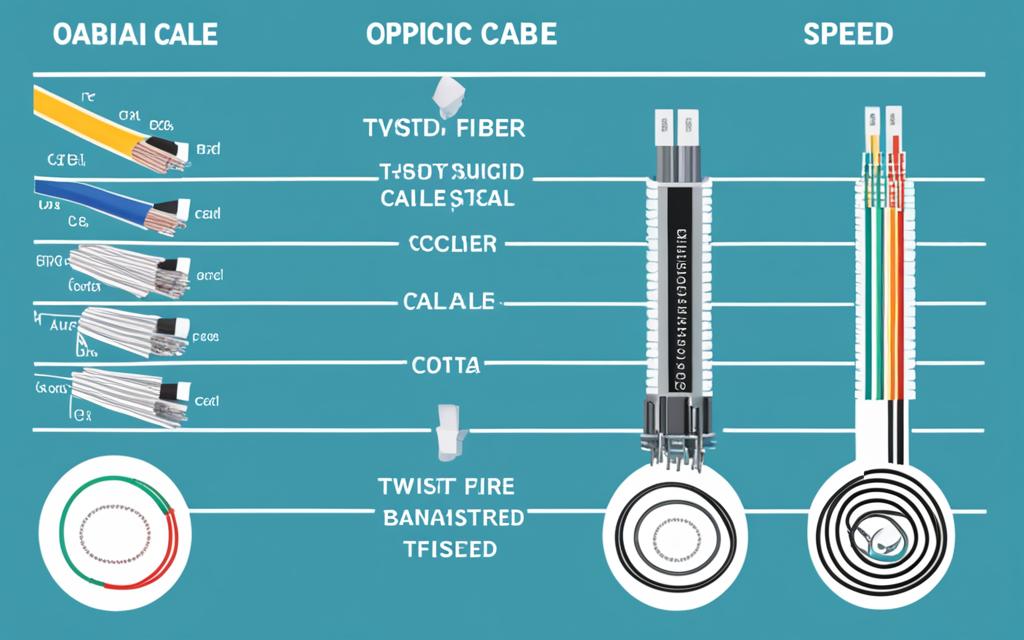
| Features | Coaxial Cable | Twisted Pair Cable | Fiber Optic Cable |
|---|---|---|---|
| Bandwidth | High | Low | Very High |
| Transmission Distance | Long | Short | Long |
| Signal Interference | Moderate | High | Minimal |
| Installation Cost | High | Low | High |
| Availability | Moderate | High | Moderate |
| Environmental Resistance | Good | Fair | Excellent |
Conclusion
Coaxial cable and twisted pair cable are two common types of networking cables that serve different purposes. Coaxial cable offers better shielding, longer distance transmission, and higher bandwidth, making it suitable for applications such as internet connections, television signal distribution, and radio transmissions. However, it comes at a higher cost and can be challenging to install in tight spaces. On the other hand, twisted pair cable is less expensive, easier to install, and widely available, making it ideal for telephone networks and cable shielding, but it has limitations in terms of signal interference, distance transmission, and bandwidth.
When deciding between coaxial cable and twisted pair cable, it is important to consider the specific requirements of your networking needs. If you prioritize signal quality, longer transmission distances, and higher bandwidth, coaxial cable may be the better choice. However, if cost-effectiveness, ease of installation, and availability are important factors, twisted pair cable may be more suitable. It is essential to evaluate factors such as transmission distance, signal quality, cost, and ease of installation to make an informed decision.
Ultimately, the choice between coaxial cable and twisted pair cable depends on the specific needs of your networking application. Both types of cables have their advantages and disadvantages, and understanding these differences will help you find the most suitable option for your networking requirements. Whether you choose coaxial cable or twisted pair cable, both are essential components of network infrastructure that enable seamless communication and data transmission.
FAQ
What is the difference between coaxial cable and twisted pair cable?
Coaxial cable consists of a solid conductor, insulation, and a grounding conductor, while twisted pair cable comprises two insulated copper wires twisted together.
What are the advantages of using coaxial cable?
Coaxial cable offers better shielding, longer distance transmission, and higher bandwidth.
What are the disadvantages of using coaxial cable?
Coaxial cable is more expensive and difficult to install, especially in tight spaces.
What are the advantages of using twisted pair cable?
Twisted pair cable is less expensive, easier to install, and widely available.
What are the disadvantages of using twisted pair cable?
Twisted pair cable is more susceptible to signal interference, has a limited transmission distance, and has lower bandwidth.
What are the similarities between coaxial cable and twisted pair cable?
Both types of cables can transmit data in networking applications, have multiple layers of insulation and shielding, and are used for various purposes, such as in LANs, WANs, and internet connections.
What are the differences between coaxial cable and twisted pair cable?
Coaxial cable transmits signals through the inner conductor, while twisted pair cable transmits signals through the metallic conducting wires. Coaxial cable has a higher speed and better noise protection, while twisted pair cable has a lower speed and lower noise immunity.
How does coaxial cable compare to fiber optic cable?
Coaxial cable offers better shielding and longer distance transmission, while fiber optic cable can carry more data and is ideal for high-speed and long-distance applications.
How does twisted pair cable compare to fiber optic cable?
Twisted pair cable is less expensive and easier to install, while fiber optic cable can carry more data and is ideal for high-speed and long-distance applications.

